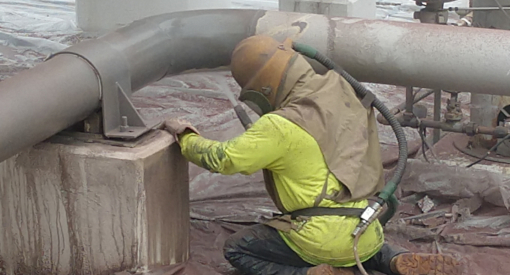Selecting the Right Industrial Painting Contractor for Your Job
Why do people paint their homes, businesses, structures and products?
The answer is twofold – to protect and/or make things aesthetically pleasing. Painting, or using a coating to cover an item, helps to protect it from damage and corrosion. The clean, smooth and sometimes colorful finish gives it a desirable look and feel.
But painting is not as easy as saying, “I’ll grab a bucket, a brush, and slap on a coat of paint.”

In order to get that desirable end result, you must first consider what you’re applying that material to, how to apply the coating and what you want the end result to look like.
In addition, the best way to prepare the surface prior to painting is critical. Without proper preparation, the end result can be greatly impacted.
Sound overwhelming?
That’s exactly why industrial painting contractors are hired. They have the knowledge and expertise to help you achieve your goal.
But painting structural steel versus applying tank linings requires a vastly different approach to the work.
7 Steps to Selecting the Right Industrial Painting Contractor for Your Job
How do you know which contractor has the right skills for your job? Consider these seven steps when planning out your project:
 Define your Scope of Work
Define your Scope of Work
There are three main types of painting contractors so it’s a good idea to start your search by narrowing the field down.
While some of the larger companies may work in more than one area, painting contractors tend to specialize in three main areas:
- Residential painting contractors’ work would involve painting in your home.
- Commercial painting contractors would typically be needed for a painting project for your business, like a retail store.
- Industrial painting contractors are typically involved with work at manufacturing plants, power plants, bridges, natural gas assets, water towers, stadiums, universities or naval ships.
The rest of this article will focus on the industrial painting sector.
Each type of project has its own unique challenges and things to consider. You can start by answering the following questions during your planning process in order to define your scope of work:
- Do I need an industrial painting contractor for this project?
- What type of painting contractor do I need for this project?
- Where is my project located?
- What, if any, environmental challenges/concerns are there?
- By when, do I need my project completed?
- Are there additional construction services that I need the contractor to complete?
 Who do you need to involve in the project planning and decision making?
Who do you need to involve in the project planning and decision making?
The most obvious person to involve is the Project Manager. However, not all Project Managers have the authority to make the project budget or financial decisions. Depending upon the scope of the project, there may be several Project Managers or even a purchasing team to include.
In addition, Operations or Facility Managers may need to be involved in order to develop an appropriate timeline, prioritization of the project, or to ensure that operations are not interrupted by the work being done.
For example, work could potentially be done during off hours, an outage at a power plant, or when volume is lower in a manufacturing environment.
Finally, you need to consider which contractors you would like to include in the bid process.
Occasionally, the contractors may be helpful to you in developing the specs for your bid package. Their questions asked concerning the project can lead to further clarification of needs and job requirements. On the other hand, you may wish to bring in the contractors later after the specs have been finalized.
 Determine Your Budget
Determine Your Budget
The process for determining your project budget is often unique to every organization. The bottom line here is that you need to know what you are able to spend.
If you’ve done many similar projects, you should have a good idea of what it will take to complete your project. If your project is unique, you may have to get some feedback from either potential contractors or others in the industry.
 Establish a Timeline
Establish a Timeline
In order to establish an overall project timeline, two separate timelines need to be created:
- One for project completion that includes the work getting done.
- One for selecting a contractor.

WHEN SELECTING A CONTRACTOR, CONSIDER THE FOLLOWING
- How long do you need to prepare and receive bid packages?
- Does this timeline give the contractors time to do a project site visit, if necessary?
- Is a pre-bid meeting necessary?
- How much time do you need to review the bids you receive?
- How much time have you allotted in between awarding the job and when the contractors can start working on the project?
FOR THE PROJECT TIMELINE, CONSIDER THE FOLLOWING
- By when do you need to have the project completed?
- Are there compliance dates that need to be met?
- What is a reasonable timeline in which to get this done?
- Are there specific timeframes that you need to adhere to in order to minimize the disruption of business?
- When will the funds be available in order to complete this project?
 Create a Bid Document
Create a Bid Document
The type of coating you use is dependent upon on the material it is being applied to and the many types of surface preparations that may need to be done.
While you may be aware of what the best application is for your job, industrial painting contractors or coatings manufacturer sales representatives are able to assist you in determining which products are going to do the best job at protecting your assets.
Have a Question About Your Project?
Do you have a question about an upcoming tank lining or another industrial painting project? If so, contact one of our experts. We won’t only answer your question, but also point you in the right direction.
Preparation
In addition to the product that you wish to use to coat, think about how you want the area to be prepped for coating. For example:
- Are any of these products or processes a requirement of the job?
- What is the proper paint system to meet my needs?
- What exposure will the coatings have to withstand on a daily basis?
If you don’t know, just ask!
Finally, to ensure that your bidders are clear on the scope of the project, it is recommended to hold a pre-bid meeting and/or bid-walk.
This allows contractors to ask questions and get a first-hand look at the project. It also helps to increase the likelihood that when you receive your bid responses you are able to compare apples to apples.
 Determine Bidders List
Determine Bidders List
Everyone knows that when hiring a contractor, it’s a good idea to check their credentials or pre-qualify.
Hiring an industrial painting contractor is no exception. Two main credentials you may want to look for are from a NACE International and the Society for Protective Coatings (SSPC) organizations. While each of these organizations offer a variety of types of certifications within the industrial painting industry, knowing a contractor is committed to the high quality and standards of these organizations is key.
Aside from quality work, the National Council on Compensation Insurance (NCCI) gives companies a rating for safety called an Experience Modification Rate (EMR).
This rating helps as an indicator of safety standards in the workplace and is largely calculated upon actual insurance, the number of worker’s compensation claims a company has had in a three-year period, the type of incident that occurred, and the monetary value of the claim.
It is also a good idea to check a contractor’s safety statistics over a three to five year period, review their insurance coverages and check the financial viability of the company.
FOR THE BIDDERS LIST, CONSIDER THE FOLLOWING:
- How long have they been in business?
- Which contractors are qualified to do the job?
- What companies are willing/able to work where the project is located?
- What companies have completed similar projects in the past?
- Which certifications and trainings are important for the contractor’s employees to have?
- What is the company’s reputation in the industry?
- Do they do quality work?
- Do they work safely and what is their EMR (Experience Modification Rate)?
- Are they ethical in how they operate?
 Award the job!
Award the job!
After you (and whomever might be included on your project team) have reviewed the contractors’ bid responses, you need to select a contractor.
While price is always a key consideration, it is advisable to think about several other factors.
First, has the contractor been easy to work with in the past and throughout the bid process?
If not, why not? Occasionally, there is a valid reason for either poor communication or lack of responsiveness of a contractor. Consider this accordingly.
Is there any reason to go back to a bidder and clarify why their number was either much higher/lower than other contractors?
Maybe the low bidder left something out, chose to use a different product than requested, or is the least experienced with this type of work? While you would hope that the contractor knows what they are doing when submitting their bid, there’s nothing worse than finding out later that how something was defined in the bid documents could be interpreted another way.
CONCLUSION
There’s never a way to account for all of the project-specific pitfalls you may encounter when planning for your next industrial painting project, however, this seven-step process is a good way to begin and determine who needs to be a part of your project team. The more projects you complete, the more you will be able to tailor this plan to your company’s own specific needs“, and, hopefully, select the best contractor for your job.
